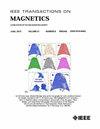A 3-D Forward Model of Metal Magnetic Memory Method for Quantitative Defect Detection
IF 2.1
3区 工程技术
Q3 ENGINEERING, ELECTRICAL & ELECTRONIC
引用次数: 0
Abstract
Metal magnetic memory (MMM) has gained attention in both academia and industry as a nondestructive testing (NDT) method capable of achieving early diagnosis of ferromagnetic materials and structures under various stress states and damage forms. The quantitative MMM detection, however, has been limited in engineering applications due to the imprecision of the quantitative relationship between stress-magnetization-defect size, the poor similarity between the simplified geometries of the characterization model and the actual defects, as well as the inability of the characterization signals to accurately reflect the spatial distribution of the magnetic field at the defects. In this article, in order to be consistent with engineering defects, the ellipsoid defect is adopted as the research object. Based on the combination of hysteresis characteristics, demagnetization energy, and finite element method, the quantitative relationship between stress vector, magnetic charge density, and defect size is derived, and an MMM detection forward model for defects containing an inhomogeneous distribution of stresses is established. The results of the experiments show that the predictions of the model agree with the experimental data both qualitatively and quantitatively. On this basis, the spatial distribution characteristics of the 3-D signal components at the defect were analyzed, and the advantages of the previously unnoticed X-directional component in determining the shape and size of the defect were revealed. Meanwhile, the influence laws of dimensional parameters, lift-off height, stress, and burial depth on the MMM signals are discussed in detail, which provides a theoretical basis for the quantitative identification of defects in practical engineering.用于定量缺陷检测的金属磁记忆法三维前向模型
金属磁记忆(MMM)作为一种无损检测(NDT)方法,能够对各种应力状态和损伤形式下的铁磁材料和结构进行早期诊断,因此受到学术界和工业界的关注。然而,由于应力-磁化-缺陷尺寸之间的定量关系不精确,表征模型的简化几何形状与实际缺陷之间的相似性较差,以及表征信号无法准确反映缺陷处磁场的空间分布,因此 MMM 定量检测在工程应用中受到了限制。为了与工程缺陷保持一致,本文以椭圆形缺陷为研究对象。在结合磁滞特性、退磁能量和有限元法的基础上,得出了应力矢量、磁荷密度和缺陷尺寸之间的定量关系,并建立了针对含有不均匀应力分布缺陷的 MMM 检测前向模型。实验结果表明,该模型的预测与实验数据在定性和定量方面都一致。在此基础上,分析了缺陷处三维信号分量的空间分布特征,揭示了之前未被注意到的 X 方向分量在确定缺陷形状和尺寸方面的优势。同时,详细讨论了尺寸参数、升起高度、应力和埋深对 MMM 信号的影响规律,为实际工程中缺陷的定量识别提供了理论依据。
本文章由计算机程序翻译,如有差异,请以英文原文为准。
求助全文
约1分钟内获得全文
求助全文
来源期刊

IEEE Transactions on Magnetics
工程技术-工程:电子与电气
CiteScore
4.00
自引率
14.30%
发文量
565
审稿时长
4.1 months
期刊介绍:
Science and technology related to the basic physics and engineering of magnetism, magnetic materials, applied magnetics, magnetic devices, and magnetic data storage. The IEEE Transactions on Magnetics publishes scholarly articles of archival value as well as tutorial expositions and critical reviews of classical subjects and topics of current interest.
 求助内容:
求助内容: 应助结果提醒方式:
应助结果提醒方式:


